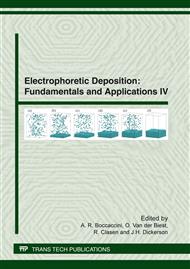[1]
Y. Hirata, A. Nishimoto and Y. Ishihara, Forming of Alumina Powder by Electrophoretic Deposition, J. Ceram. Soc. Jpn. 99 (1991) 108-113.
DOI: 10.2109/jcersj.99.108
Google Scholar
[2]
M. N. Naim, M. Kuwata, H, Kamiya and W. Lenggoro, Deposition of TiO2 Nanoparticles in Surfactant-Containing Aqueous Suspension by a Pulsed DC Charging-Mode Electrophoresis, J. Ceram. Soc. Jpn. 117 (2009) 127-132.
DOI: 10.2109/jcersj2.117.127
Google Scholar
[3]
B. Neirinck, J. Fransaer, O. Van der Biest and J. Vleugels, Aqueous Electrophoretic Deposition in Asymmetric AC Electric Fields (AC-EPD), Electrochem. Commun. 11 (2009) 57-60.
DOI: 10.1016/j.elecom.2008.10.028
Google Scholar
[4]
A. R. Gardeshzadeh, B. Raissi, E. Marzbanrad, Preparation of Si powder thick films by low frequency alternating electrophoretic deposition, J. Mater. Sci. 43 (2008) 2507-2508.
DOI: 10.1007/s10853-008-2519-z
Google Scholar
[5]
A. R. Gardeshzadeh, B. Raissi, E. Marzbanrad and H. Mohebbi, Fabrication of Resistive CO Gas Sensor Based on SnO2 Nanopowders Via Low Frequency AC Electrophoretic Deposition, J. Mater. Sci.: Mater. Electron. 20 (2009) 127-131.
DOI: 10.1007/s10854-008-9652-y
Google Scholar
[6]
R. Riahifar, E. Marzbanrad, B. Raissi and C. Zamani, A new technique for micro-patterning of nanoparticles on non-conductive substrate by low frequency AC electrophoresis, J. Mater. Sci.: Mater. Electron. 22 (2011) 1218-1221.
DOI: 10.1007/s10854-011-0288-y
Google Scholar
[7]
R. Riahifar, E. Marzbanrad, B. Raissi, C. Zamani, M. Kazemzad and A. Aghaie, Sorting ZnO particles of different shapes with low frequency AC electric field, Mat. Lett. 65 (2011) 632-635.
DOI: 10.1016/j.matlet.2010.08.029
Google Scholar
[8]
B. Raissi, E. Marzbanrad and A. R. Gardeshzadeh, Particle Size Separation by Alternating Electrophoretic Deposition, J. Eur. Ceram. Soc. 29 (2009) 3289–3291.
DOI: 10.1016/j.jeurceramsoc.2009.05.028
Google Scholar
[9]
R. Riahifar, E. Marzbanrad, B. Raissi and C. Zamani, Effect of parameters on deposition pattern of ceramic nanoparticles in non-uniform AC electric field, J. Mater Sci.: Mater Electron, 22 (2011) 40-46.
DOI: 10.1007/s10854-010-0079-x
Google Scholar
[10]
A. Ramos, H. Morgan, N. G. Green and A. Castellanos, AC Electric-Field-Induced Fluid Flow in Microelectrodes, J. Colloid Interface Sci. 217 (1999) 420–422.
DOI: 10.1006/jcis.1999.6346
Google Scholar
[11]
A. Y. Sinyagin, A. Belov, Z. Tang and N. A. Kotov, Monte carlo computer simulation of chain formation from nanoparticles, J. Pys. Chem. B. 110 (2006) 7500-7507.
DOI: 10.1021/jp057105e
Google Scholar
[12]
E. k. Heidari, C. Zamani, E. Marzbanrad, B. Raissi, S. Nazarpour, WO3-based NO2 sensors fabricated through low frequency AC electrophoretc deposition, Sens. Actuators, B. 146 (2010) 165-170.
DOI: 10.1016/j.snb.2010.01.073
Google Scholar


